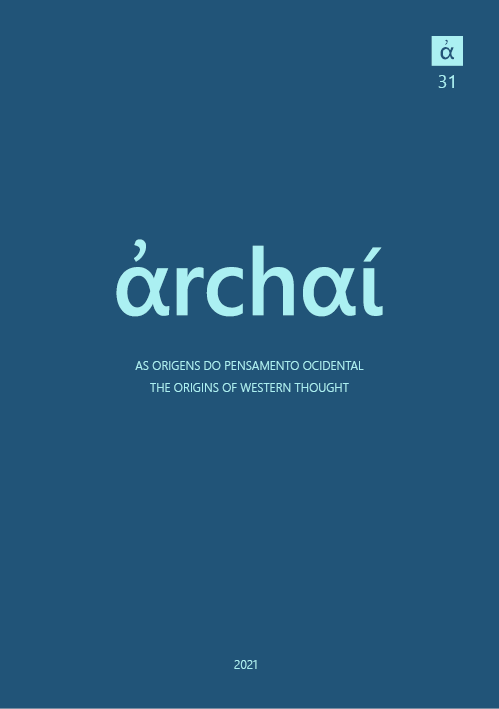Teaching sophrosyne: The use of the elenchos by Xenophon's Socrates
DOI:
https://doi.org/10.14195/1984-249X_31_08Keywords:
Xenophon, elenchos, sophrosyne, education, politicsAbstract
The Socratic elenchos in Xenophon's work plays a central role even though it may seem to have a secondary part. The following article aims to work on the xenophontic characterization of the Socratic elenchos, as well as his assessment from the point of view of its educational qualities. In this sense, the socratic elenchos potentialities will be analyzed in three directions: first, the strictly formative dimension; secondly, its role for acting in political affairs; and, finally, his contribution to the acquisition of the sophrosyne. Through this analysis I will explain why the portrait made by Xenophon of the Socratic elenchos should be understood as supplementary to the portraits made by others (like Plato) and not as an alternative to them.
Downloads
References
AHBEL-RAPPE, S., R. KAMTEKER (eds.) (2009). A Companion to Socrates. Oxford, Wiley-Blackwell.
BENSON, H. (1987). “The problem of the Elenchus reconsidered”. Ancient Philosophy 7. p. 67-85.
BENSON, H. (1995). “The Dissolution of the Problem of the Elenchus”. Oxford Studies in Ancient Philosophy 13. p. 45-112.
BEVILACQUA, F. (2018). “An Explicit Political Plan: Memorabilia II, 6, 22-27”. En: Danzig, Johnson y Morrison (eds). Plato and Xenophon: Comparative Studies. Mnemosyne Suppl. 417. Leiden, Brill. p. 461-486.
DANZIG, G. (2010). Apologizing for Socrates. Lanham, Lexington. DANZIG, G. (2012). “The best of the Achaemenids: Benevolence, self-interest and the ‘ironic’ reading of Cyropaedia”. En: F. Hobden y C. Tuplin (eds.) Xenophon: Historical Method and Moral Principle. Leiden, Brill. p. 499-539.
DANZIG, G. (2014). “Alcibiades versus Pericles: Apologetic Strategies in Xenophon’s Memorabilia”. Greece and Rome 61. p. 7- 28.
DANZIG, G. (2017). “Nature, Culture and The Rule of the Good in Xenophon’s Socratic Theory of Friendship: Memorabilia Book Two”. En: MOORE y STAVRU (eds.) Socrates and the Socratic Dialogue. Leiden and Boston, Brill. p. 459-480.
DORION, L.-A., M. BANDINI. (2010). Xénophon Mémorables. Paris, Les Belles Lettres.
DORION, L.-A. (2002). “La responsibilité de Cyrus dans le déclin de l’empire perse selon Platon et Xénophon”. Revue Française d’Histoire des Idées Politiques 16. p. 369-386.
DORION, L.-A. (2004). Platon. Charmide Lysis. Paris, Flammarion.
DORION, L.-A. (2009). “Xenophon’s Sócrates”. En: AHBEL- RAPPE y KAMTEKER (eds.). A companion to Socrates. Oxford, Blackwell. p. 93-109.
DORION, L.-A. (2013). L’Autre Socrate: Études sur les écrits socratiques de Xénophon. Paris, Les Belles Lettres.
GERA, D. (1993). Xenophon’s Cyropaedia. Oxford, Oxford University Press.
HESK, J. (2003). Sophocles: Ajax. London, Duckworth.
JOHNSON, D. (2005). “Xenophon at his most Socratic (Memorabilia 4.2)”. Oxford Studies in Ancient Philosophy 29. p. 39- 73.
JOHNSON, D. (2018). “Xenophon’s Intertextual Socrates”. En: Danzig, Johnson, Morrison (eds.). Plato and Xenophon: Comparative Studies. Mnemosyne Suppl. 417. Leiden, Brill. p. 71- 98.
KAHN, Ch. (1983). “Drama and Dialectic in Plato’s Gorgias”. Oxford Studies in Ancient Philosophy 1. p. 75-121.
LACHANCE, G. (2018). “The logical form of the elenchus in Xenophon and Plato”. En: DANZIG, JOHNSON, MORRISON (eds.). Plato and Xenophon: Comparative Studies. Mnemosyne Suppl. 417. Leiden, Brill. p. 165-183.
LUZ, M. (2015). “Socrates, Alcibiades and Antisthenes in PFlor II”. En: ZILIOLI, U. (ed.) From the Socratics to the Socratic School. London, Routledge. p. 192-210.
MORRISON, D. (1994). “Xenophon’s Socrates as a Teacher”. En: WAERDT, P. V. (ed.). The Socratic Movement. Ithaca, Cornell University Press. p. 181-208.
NORTH, H. (1966). Sophrosyne: Self-Knowledge and Self-Restraint in Greek Literature. Ithaca, Cornell University Press.
POLANSKY, R. M. (1985). “Professor Vlastos’s Analysis of the Socratic Elenchus”. Oxford Studies in Ancient Philosophy 3. p. 247- 260.
RADEMAKER, A. (2005). Sophrosyne and the Rhetoric of Self- Restraint: Polysemy and Persuasive Use of an Ancient Greek Value Term. Mnemosyne Suppl. 259. Leiden, Brill.
ROBINSON, R. (1941). Plato’s Earlier Dialectic. Ithaca, Cornell University Press.
ROSSETTI, L. (2011). “L’Euthydème de Xénophon”. En: Le dialogue Socratique. Paris, Les Belles Lettres. p. 55-100.
SANDERS, K. (2011). “Don’t Blame Socrates: Xen. Mem. 1.2.40- 46”. Classical Philology Vol. 106, 4. p. 349-356.
SLINGS, S. R. (1981). A commentary on the Platonic Clitophon. Amsterdam, Academische Pers.
VLASTOS, G. (1983). “The Socratic Elenchus”. Oxford Studies in Ancient Philosophy 1. p. 27-58.
VLASTOS, G. (1985). “Socrates’ Disavowal of Knowledge”. Philosophical Quarterly 138. p. 1-31.
Downloads
Published
How to Cite
Issue
Section
License
Copyright (c) 2021 Gabriel Danzig

This work is licensed under a Creative Commons Attribution 4.0 International License.
Given the public access policy of the journal, the use of the published texts is free, with the obligation of recognizing the original authorship and the first publication in this journal. The authors of the published contributions are entirely and exclusively responsible for their contents.
1. The authors authorize the publication of the article in this journal.
2. The authors guarantee that the contribution is original, and take full responsibility for its content in case of impugnation by third parties.
3. The authors guarantee that the contribution is not under evaluation in another journal.
4. The authors keep the copyright and convey to the journal the right of first publication, the work being licensed under a Creative Commons Attribution License-BY.
5. The authors are allowed and stimulated to publicize and distribute their work on-line after the publication in the journal.
6. The authors of the approved works authorize the journal to distribute their content, after publication, for reproduction in content indexes, virtual libraries and similars.
7. The editors reserve the right to make adjustments to the text and to adequate the article to the editorial rules of the journal.



